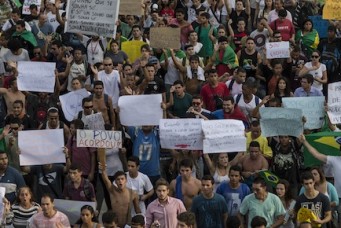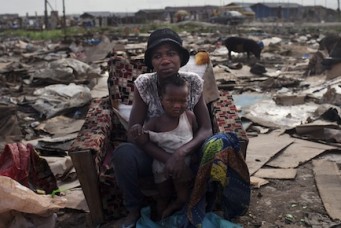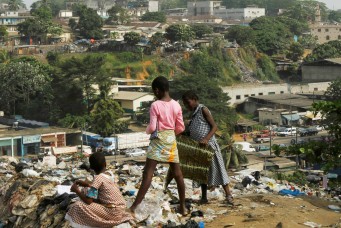Smile, You’re in Rio
When the author arrived in 1995, she purchased an armored car and retreated to a gated community. Rio de Janeiro was a city at war with itself: elites of the wealthy enclaves versus the urban poor of the favelas. Society is now changing for the better, in ways that cannot be undone.

Painting of favelas at Feira Hippie de Ipanema, Rio de Janeiro, August 2006. Judy Bellah/Getty Images
By the time we came from São Paulo to live in Rio de Janeiro, in 1995, the grubby apartments we looked at boasted wheezing psychedelic orange refrigerators. We noticed that people’s cars were older than those in São Paulo, the metropolis to which banks and businesses and even the stock market had fled in the 1980s. Trees grew out of crumbling façades.
“Buy an armored car,” advised our São Paulo friends, who thought we were crazy to move to a place at war with itself. Rio was divided between its informal and formal parts, between “hill” and “asphalt,” as the locals say. As the city developed, in the late nineteenth century, the poor were relegated to hills and swamps, to the shantytowns known here as favelas, with troublesome access both for people and infrastructure. Many favela residents worked for the upper classes, who happily squeezed into the South Zone flat areas between the hills and the ocean: Ipanema, Copacabana, and Leblon—names synonymous with Brazilian sun, surf, and sexiness.
We did buy an armored car, and hired a driver to do our errands and escort our children to and from a private school. Drug traffickers were taking over huge swathes of the informal city—often the hilltop favelas—in both the North and South Zones. In West Zone favelas, inhabited largely by construction workers who’d come from drought-stricken northern Brazil, paramilitary groups ran things. They assured Rio’s middle and upper classes that, in the absence of any actual on-duty police, they would keep drugs out of the area.
As was the case for so many middle- and upper-class Rio natives, or cariocas, our lives shrank: to our house on a gated street, the armored car, the guarded and walled homes of our friends, the shopping malls. We hugged our comfort zone, shying away from neighborhoods near favelas where stray bullets flew. You read in the papers about people who’d bricked up their windows; about motorcyclists riding up and down an Ipanema street ordering doctors’ offices, schools, and day care centers to shut down because the “owner of the hill” above said so; about a girl made a paraplegic by a stray bullet that flew into her college campus.
I think it was in 1999 that my hairdresser at a mall told me that police had kidnapped the drug lord of her favela for a day, demanding about $40,000 in ransom. Once this was arranged they let him go, and his cronies shot their weapons heavenward to celebrate. Accidently, they not only hit a transformer, putting out the lights in the favela; but they also managed to shoot a local girl—an only child and an athlete—who bled to death in the street because no one dared help her.
Another resident later repeated the story for me, but the Brazilian media didn’t carry the news. With police, politicians, and criminals in cahoots, complete and objective reporting was difficult. And after 2002, when a big-time TV reporter doing undercover work in a favela was tortured and killed by drug traffickers, Brazilian media banned their journalists from entering the city’s informal areas.
When shootings occurred, between gangs and the police or among gangs, headlines focused on the fear and suffering of those who lived on the asphalt. One didn’t think about the favela residents, who were missing school and work, losing daughters to drug lord polygamists, living daily trauma. Some 1.4 million people, or 22 percent of Rio’s residents, live in the favelas.
Gates of Barra da Tijuca
The shootings, the kidnappings, the fear—it not only limited our daily geography, it drove thousands of people out of the formal North and South Zones westward to Barra da Tijuca. Set between pristine beaches and lush mountains, and once a swampy area dotted with lagoons, Barra is a newer, exclusive district of high-rise condominiums and gated communities, elegant shopping malls, and tidy broad boulevards.
I used to drive my kids to the beach in Barra, which was cleaner than the ones in Ipanema or Copacabana, and where there was less chance of being separated from your valuables. “Smile, you’re in Barra,” a sign welcomed us as we emerged from a tunnel into this burgeoning modern suburbia. A local business association, determined to keep crime out, proposed setting up gates, medieval style, at the five entrances to Barra da Tijuca.
Not long ago, on the wall of an Ipanema construction site where workers are digging to extend the metro to Barra da Tijuca, a graffiti artist scrawled the words: “Smile, you’re not in Barra.”
I saw the graffiti and smiled indeed. My children were all grown up and I’d stopped driving to Barra, connected to the South Zone (where I live) by an eternally clogged highway. But one Friday night, I made an exception, to see a man I’d started dating who lived there. The two hours it took me to drive the nineteen kilometers from Ipanema to Barra indicated we’d begun a toilsome long-distance relationship.
By 2010, Barra was home to about 300,000 people, sparsely spread over some 166 square kilometers. In some ways, Barra’s very existence illustrates how difficult it is for people to face up to Rio’s deep social and economic inequality. When Barra started booming in the 1980s, it seemed easier to abandon the older, troubled parts of the city and recast Rio someplace else.
Asphalt residents who didn’t “Go West” put grilles on their windows, built walls and fences, installed cameras, hired guards. This became such a phenomenon that Raul Mourão, a Rio sculptor, began making installations out of window grilles—with the intent of rattling the cages of cariocas. In 2009, the window grilles gained movement, when an acrobatics company experimented with Mourão’s pieces, putting one on top of another and giving it a push. His work thus became kinetic, and to me has come to reflect Rio’s turnaround.
Pacificação
Just about everybody agrees that Luiz Inácio Lula de Silva’s election as president in 2002 began to undo centuries of socioeconomic inequality in Brazil. Some elites began to realize that inclusion was inevitable and maybe even desirable. And clearly, Lula represented the poor. In Rio, starting in 2008, another element of the turnaround was a new public safety policy called pacification—the Rio de Janeiro state government’s pacifição program focused on some key favelas. This was an experiment that contrasted sharply with years of ill-fated, periodic incursions and battles between a highly corrupt police force and drug traffickers.
Territoriality is the underlying concept—taking back territory in informal parts of the city long under criminal thumbs. The police announce the date of a planned invasion, and make sweeps to arrest known lawbreakers; a special squad then moves in, sets up bases, and secures the favela. Not a shot is fired. Journalists, no longer banned from favelas, are present and get the news out on a continuing basis. Some months later, the pacification police arrive and try to win over residents. The pacification police are meant to be fresh, unblemished recruits and specially trained in community policing. But given manpower difficulties, this hasn’t always been the case, and has led to serious problems.
By the end of 2013, Rio had pacified thirty-six territories, affecting more than a half million favela residents. The state public safety secretariat says the program has improved the lives of 1.5 million cariocas, if you count people who live either in or near pacified favelas. Pacification has halved the homicide rate, to 24 per 100,000 a year. Real estate prices and rents have risen significantly, both in and near favelas.
From 2010 to 2013, pacification was widely celebrated in the Brazilian media. Police officers held favela debutante balls, played soccer with residents, and let kids sit on their motorcycles. My manicurist said her elderly mother could walk safely in her favela’s alleys, without fear of being knocked down by a machine-gun-toting drug soldier riding a motorcycle. Standing in a top-floor play area, a public school principal told me what a difference it made for her students to know they wouldn’t have to be hiding under their desks from bullets anymore (and school performance statistics demonstrate this). Pointing to the top of the Borel favela hill, she said traffickers once watched her every move. Pointing used to be forbidden because drug lords didn’t want the attention of strangers. I took a picture of her, pointing. Taking pictures used to be forbidden, too.
Public opinion surveys in both the formal and informal parts of Rio showed overwhelming support for pacification. Middle- and upper-class cognoscenti began finding their way to favela dances, bars, and restaurants, now that it was safe. One day, after I’d been to a jazz school event at the top of a favela, I walked down twisting dim lanes, chatting with friends, skirting dog poop and trickles of sewage. Coming to the bottom of the hill, I blinked in the bright street light, realizing I was on a Copacabana street, just blocks from my apartment. The experience was eerily like those dreams one has, of a place that is familiar yet different. For years, like so many cariocas, I’d known that this favela was there, at the edge of my neighborhood. But I avoided the streets that bordered it, and marveled at the foreigners who had either the courage or the naiveté to buy apartments on them.
Lula’s socioeconomic policies achieved miracles—forty million Brazilians have been lifted out of poverty in the last decade or so. In Rio, with pacification, more trash is being picked up, more health clinics and day care centers are open, and more schools are operating as they ought to. Yet with expectations rising more people are complaining about the lack of adequate services. Basic sanitation remains horrific; residents grouse that the state installs fancy cable car systems while leaving them without proper water supply or sewage collection.
Last June, the frustration erupted into massive street demonstrations after the mayors of Rio and São Paulo approved increases in bus fares. With billions being spent on the city’s upcoming mega-events—the Fédération Internationale de Football Association, or FIFA World Cup, this year, and the 2016 Rio Olympic Games—people are publicly questioning why the country has two health care systems and two education systems. And why the underclass must use public transportation and live in favelas, while the better-off drive automobiles and live in proper houses and apartments.
Our comfort zones are expanding, even as we complain. Favela residents, when asked, will say where they actually live, instead of giving the name of the formal neighborhood nearest to home. And the names of the favelas, no longer vaguely conceived areas of extreme danger, mean something to outsiders. We now know that Complexo do Alemão, invaded by the Army in late 2010 and now pacified, is a North Zone complex of favelas where you can ride a cable car up for some astonishing views, then make your way downhill for a frosty microbrewery beer and some feijoada croquettes at Bistrô Estação R&R.
Insiders and outsiders alike know about Amarildo Gomes da Silva, the laborer and father of six who disappeared in the Rocinha favela at the hands of the police last July. Before pacification, police often shot favela residents dead, claiming self-defense. No questions were asked. But police are now rewarded with pay bonuses for reducing crime statistics, and the number of bullets they use has fallen off dramatically across the city.
For months, demonstrators carried banners demanding answers. An investigation eventually led to the indictment of twenty-five police officers and a change of command. The accused have been charged with torturing Amarildo to death, then hiding the body. Supposedly, the cops were prying Amarildo for information about local drug traffickers. The Amarildo investigation indicated that society is at last taking seriously the value of the lives of favela residents. On the other hand, his torture and death brought to light startling levels of police corruption, collusion, and incompetence.
Police violence during street demonstrations also revealed the difficulties the institution is having in transforming itself. Rio’s police corps is divided and riddled with conflicting allegiances. Off-duty and retired cops form the basis of the paramilitary groups that control West Zone favelas, known for extorting residents, running informal transportation services, and selling cooking gas. These groups have a dangerous presence on the city council and even in state legislature, giving Rio’s mayor a markedly strong (if not authoritarian) hand. Crime, in fact, has begun to make a comeback, with statistics on the rise as of mid-2013. Critics claim that criminals are migrating to non-pacified favelas and to other cities in the region.
Life of the Cariocas
A key program in Rio’s turnaround hasn’t yet got off the ground, despite enormous boosterism at the start, only three years ago. Part of the problem is that political alliances are coming unstitched; Rio’s municipal housing secretariat is run by a party preparing to oppose the mayor and governor’s party in elections this year. The program, Morar Carioca, or Carioca Life, is meant to upgrade all of Rio’s favelas by 2020. The city, in conjunction with the Brazilian Institute of Architects, held a historic competition, won by forty architectural firms, with pioneering proposals to make favela life more sustainable and integrate these areas into the formal city, encouraging interchange.
For now, Rio’s favelas—although some are safer and more accessible—mostly remain an underclass world. A foreign researcher who lives in a pacified favela that has seen considerable public investment tells me he can only escape the sewage smell when he shuts the door to his room. He fears both traffickers and police. The alleys are claustrophobic, he says. “I can see why it’s impossible to police,” he told me.
The government has been trying to meet demand for low-income housing, and has constructed federally funded homes and apartment blocks under the Minha Casa Minha Vida (My Home My Life) program. These are often poorly constructed and located at the edges of the city, with little regard for the strong community ties that favela life supports.
Pacification has shaken us all up, for better or worse. The retaking of informal territory implicitly requires urban integration, the recognition that those who live in favelas are just as human as those who don’t. That implies that everyone enjoys the same rights to the entire city, a concept still new to those whose families migrated to Barra da Tijuca, or put up gated fences in front of their North and South Zone apartment buildings.
As I seek to better understand the place that has been my home for so many years, I feel by turns thrilled, unnerved, and frustrated. Whether Rio’s elite like it or not, Brazilian society has begun to change in ways that can’t be undone. I suspect that a deep cultural shift will influence, along with the voices of young middle-class protestors, both politics and policy for years to come; even if a faltering economy sends people back into poverty, they will have had the experience of carrying formal work papers, of gaining some basic educational skills, of learning how to Google. Their social invisibility has come to an end. Increasing numbers of favela residents are enrolled in university, competing for spots there and later, for jobs. Elites who have traditionally depended on networking for professional success now have to contend with these newcomers.
Even the map of Rio is changing. Barra da Tijuca will be connected to the rest of the city after the extension of the metro and the addition of several dedicated bus lanes. The North Zone boasts a giant new park and, given the pacification of most of its favelas, is attracting real estate and commercial investment. The revitalization of the Guanabara Bay port area is significantly expanding Rio’s traditional downtown.
In 2011, during work around the port, the Cais do Valongo slave wharf was accidentally unearthed by laborers installing a new drainage system. A million or so slaves are thought to have trod its paving stones, before the wharf was covered over for the arrival of Brazil’s future empress Teresa Cristina in the mid-1800s. Its location and function were forgotten. Authorities and conservationists quickly understood the importance of the discovery for Rio’s African heritage. Already, the paving stones are uncovered. Cais do Valongo has become a tourist attraction.
Julia Michaels writes RioReal blog, a bilingual account of life in Rio de Janeiro. She is the author of Arpoador Tribute, a collection of photos and short essays in English and Portuguese about South Zone Rio beach. Her memoir, Solteira No Rio de Janeiro, was published in 2013. On Twitter:@riorealblog.
Subscribe to Our Newsletter





